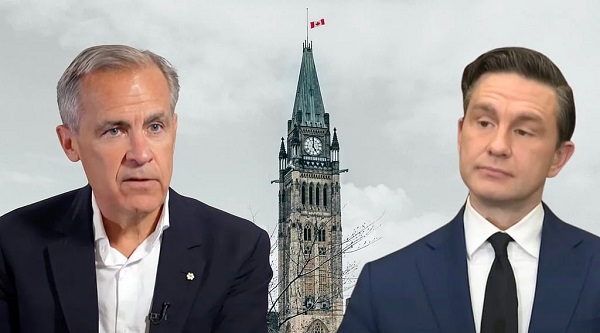Economy
Feds ‘net-zero’ agenda is an anti-growth agenda

From the MacDonald Laurier Institute
By Chris Sankey
Canada’s goal should not be to eliminate fossil fuels, but to carry out a steady and manageable reduction of emissions
The federal government is pushing an aggressive emissions reduction strategy that could devastate the Canadian economy and threaten our way of life. This isn’t just about the oil & gas industry. Port-related industries, transportation, infrastructure, health and education, and countless other sectors will be collateral damage. As will the standard of living of everyday Canadians.
One need only peek behind the curtain to understand the current course of federal policy.
Ottawa’s anti-fossil fuels agenda appears to be rooted in the ideas of two ideologically driven behind-the-scenes entities: Senators for Climate Solutions (SFCS) and Clean Energy Canada (CEC).
A group of 44 Canadian Senators, led by Sens. Mary Coyle and Stan Kutcher (both of Nova Scotia), launched SFCS in the fall of 2022. The Senators also recruited a team of interns from GreenPAC, a Toronto-based environmental lobby group, to help get SFCS up and running. GreenPAC Executive Director Sarah Van Exan told blog The Energy Mix at the time that the group had recently assigned its first-ever Senate intern to the office of Sen. Coyle.
“We saw the chance to lend critical capacity—with communication, coordination, and policy research—to help them get established,” Van Exan told The Energy Mix in an email. “The group’s cross-partisan aim and determination to put a climate lens on legislation, advance climate solutions, and hold the government’s feet to the fire is exciting.”
This team of ‘climate-minded’ Senators draws lightly on expertise from Western Canada, let alone calling on experienced energy experts from Alberta. Of the dozen experts listed on the SFCS website, just two – University of Calgary Geosciences professor Sara Hastings-Simon and Vancouver Island farmer Andrew Rushmere – are based in Western Canada.
12 years earlier, Clean Energy Canada was established as a subsidiary of the Morris J. Wosk Centre for Dialogue at Simon Fraser University (SFU) in Burnaby, BC. The group is the brainchild of Merran Smith, a figure The Province once described as “the spawn of the tendrilous and pervasive eco-activist group Tides Canada and [SFU].” Smith first came to prominence in the early 2000s while campaigning to protect coastal BC’s Great Bear Rainforest, rubbing elbows with the likes of Tzeporah Berman (an anti-pipeline acticist so extreme she was booted from the Alberta NDP’s Oil Sands Advisory Group). Other members of the team include BC Green Party alum Evan Pivnick and Electric Vehicle (EV) evangelist Meena Bibra. According to its own website, CEC’s mission is to “accelerate the transition to a renewably powered economy” via “inform[ing] policy leadership.”
Are these the sorts of people the Trudeau Government should be listening to on climate matters?
Let me give you a few stats and you be the judge. I recently had a chance to listen to Adam Waterous, the CEO of the Waterous Energy Fund and former Global Head of Investment Banking at Scotia Waterous. He is, I may add, an incredibly intelligent businessman who lives and breathes energy.
Adam shared some surprising facts about EVs. For instance, he mentioned that it takes five times the amount of oil to build an EV than it does to build a conventional gas-powered vehicle. In order offset this difference, a person must drive an EV 120,000 kms using the electrical grid. Meaning, every time we build an EV demand for oil goes up, not down. Further, an EV battery does not last the lifetime of the vehicle itself, crapping out in as little as 8 years. This expands the EV’s carbon footprint even further as producing a single EV-grade battery emits over seven tonnes of C02e emissions. All told, an EV has roughly double the production footprint of a conventional vehicle.
Still convinced we are saving the planet?
The BC provincial government is forging ahead with a set of policies that its own modelling shows will make BC’s economy $28 billion smaller in 2030 than it would be absent these policies. (To put this number into context, this is roughly what the province spends on health care each year). This will set prosperity back more than a decade. This remarkable finding emerges from looking beyond the government’s glossy reports to the raw modelling results of the estimated economic impact of CleanBC policies that are studiously ignored in its public communication materials.
Similarly, Alberta Electric System Operator (AESO) estimates the cost of achieving a net zero electricity grid by 2050 to be nearly $200 billion, while the AESO Net-Zero Emissions Pathways report estimates that accelerating this timeline to 2035 could add an extra $45 to $52 billion. (That is without factoring in the costs of co-generation or the full distribution system and integration costs). Moving to net zero by 2050 will also eliminate 10,000 direct jobs in the oil and gas sector and an estimated 2.7 million jobs in total.
All provinces, and every Canadian household, will be impacted by the federal emissions reduction strategy. However, no province will be impacted more than Alberta. The currently federal modelling used to develop the clean electricity regulations (CER) does not properly represent Alberta’s Electricity Market and thus is unable to adequately forecast the economics of energy production. Canada’s proposed emissions intensity limit effectively requires natural gas backed power plants to sequester an annual average of 95% of all associated emissions through CCUS or other technologies (CCUS) or other technologies. As of writing, no natural gas generation with CCUS modifications has ever hit this mark.
The CERs create significant investment risk for (CCUS) projects as the physical standard for the technology is unproven. Adding insult to injury, the federal government is proposing a 20-year end-of-life for natural gas facilities built prior to January 2025. This will result in some of the cleanest gas plants in the world being shut down decades before they run their useful life; all while Asia continues to burn coal at a record pace.
Canada is about to enter a world of self-inflicted economic pain at precisely the time that Indigenous communities are finally starting harness their resource wealth. We finally made it to the corporate table where we have a seat, a say and ownership – and now the federal government wants to take it all away. How is that for bad timing?
Without reliable and affordable energy, Canadians will be left choosing between shelter, food and keeping the lights on. I don’t know about you, but I will not follow those politicians and organizations driving our climate policies to extremes, into ankle deep water, but I will listen to and follow serious people like Adam Waterous.
The goal for Canada should not be to eliminate fossil fuels. The goal needs to be a steady and manageable reduction of emissions. We must get our ethical and clean energy out to the world. Our economic future depends on it.
Chris Sankey is a former elected Councilor for Lax Kw’alaams Band, businessman and Senior Fellow for the Macdonald-Laurier Institute.
Business
Will the Port of Churchill ever cease to be a dream?

From Resource Works
The Port of Churchill has long been viewed as Canada’s northern gateway to global markets, but decades of under-investment have held it back.
A national dream that never materialised
For nearly a century, Churchill, Manitoba has loomed in the national imagination. In 1931, crowds on the rocky shore watched the first steamships pull into Canada’s new deepwater Arctic port, hailed as the “thriving seaport of the Prairies” that would bring western grain “1,000 miles nearer” to European markets. The dream was that this Hudson Bay town would become a great Canadian centre of trade and commerce.
The Hudson Bay Railway was blasted across muskeg and permafrost to reach what engineers called an “incomparably superior” harbour. But a short ice free season and high costs meant Churchill never grew beyond a niche outlet beside Canada’s larger ports, and the town’s population shrank.
False starts, failed investments
In 1997, Denver based OmniTrax bought the port and 900 kilometre rail line with federal backing and promises of heavy investment. Former employees and federal records later suggested those promises were not fully kept, even as Ottawa poured money into the route and subsidies were offered to keep grain moving north. After port fees jumped and the Canadian Wheat Board disappeared, grain volumes collapsed and the port shut, cutting rail service and leaving northern communities and miners scrambling.
A new Indigenous-led revival — with limits
The current revival looks different. The port and railway are now owned by Arctic Gateway Group, a partnership of First Nations and northern municipalities that stepped in after washouts closed the line and OmniTrax walked away. Manitoba and Ottawa have committed $262.5 million over five years to stabilize the railway and upgrade the terminal, with Manitoba’s share now at $87.5 million after a new $51 million provincial pledge.
Prime Minister Mark Carney has folded Churchill into his wider push on “nation building” infrastructure. His government’s new Major Projects Office is advancing energy, mining and transmission proposals that Ottawa says add up to more than $116 billion in investment. Against that backdrop, Churchill’s slice looks modest, a necessary repair rather than a defining project.
The paperwork drives home the point. The first waves of formally fast tracked projects include LNG expansion at Kitimat, new nuclear at Darlington and copper and nickel mines. Churchill sits instead on the office’s list of “transformative strategies”, a roster of big ideas still awaiting detailed plans and costings, with a formal Port of Churchill Plus strategy not expected until the spring of 2026 under federal–provincial timelines.
Churchill as priority — or afterthought?
Premier Wab Kinew rejects the notion that Churchill is an afterthought. Standing with Carney in Winnipeg, he called the northern expansion “a major priority” for Manitoba and cast the project as a way for the province “to be able to play a role in building up Canada’s economy for the next stage of us pushing back against” U.S. protectionism. He has also cautioned that “when we’re thinking about a major piece of infrastructure, realistically, a five to 10 year timeline is probably realistic.”
On paper, the Port of Churchill Plus concept is sweeping. The project description calls for an upgraded railway, an all weather road, new icebreaking capacity in Hudson Bay and a northern “energy corridor” that could one day move liquefied natural gas, crude oil, electricity or hydrogen. Ottawa’s joint statement with Manitoba calls Churchill “without question, a core component to the prosperity of the country.”
Concepts without commitments
The vision is sweeping, yet most of this remains conceptual. Analysts note that hard questions about routing, engineering, environmental impacts and commercial demand still have to be answered. Transportation experts say they struggle to see a purely commercial case that would make Churchill more attractive than larger ports, arguing its real value is as an insurance policy for sovereignty and supply chain resilience.
That insurance argument is compelling in an era of geopolitical risk and heightened concern about Arctic security. It is also a reminder of how limited Canada’s ambition at Churchill has been. For a hundred years, governments have been willing to dream big in northern Manitoba, then content to underbuild and underdeliver, as the port’s own history of near misses shows. A port that should be a symbol of confidence in the North has spent most of its life as a seasonal outlet.
A Canadian pattern — high ambition, slow execution
The pattern is familiar across the country. Despite abundant resources, capital and engineering talent, mines, pipelines, ports and power lines take years longer to approve and build here than in competing jurisdictions. A tangle of overlapping regulations, court challenges and political caution has turned review into a slow moving veto, leaving a politics of grand announcements followed by small, incremental steps.
Churchill is where those national habits are most exposed. The latest round of investment, led by Indigenous owners and backed by both levels of government, deserves support, as does Kinew’s insistence that Churchill is a priority. But until Canada matches its Arctic trading rhetoric with a willingness to build at scale and at speed, the port will remain a powerful dream that never quite becomes a real gateway to the world.
Headline photo credit to THE CANADIAN PRESS/John Woods
Business
Canada is failing dismally at our climate goals. We’re also ruining our economy.

From the Fraser Institute
By Annika Segelhorst and Elmira Aliakbari
Short-term climate pledges simply chase deadlines, not results
The annual meeting of the United Nations Conference of the Parties, or COP, which is dedicated to implementing international action on climate change, is now underway in Brazil. Like other signatories to the Paris Agreement, Canada is required to provide a progress update on our pledge to reduce greenhouse gas (GHG) emissions by 40 to 45 per cent below 2005 levels by 2030. After decades of massive government spending and heavy-handed regulations aimed at decarbonizing our economy, we’re far from achieving that goal. It’s time for Canada to move past arbitrary short-term goals and deadlines, and instead focus on more effective ways to support climate objectives.
Since signing the Paris Agreement in 2015, the federal government has introduced dozens of measures intended to reduce Canada’s carbon emissions, including more than $150 billion in “green economy” spending, the national carbon tax, the arbitrary cap on emissions imposed exclusively on the oil and gas sector, stronger energy efficiency requirements for buildings and automobiles, electric vehicle mandates, and stricter methane regulations for the oil and gas industry.
Recent estimates show that achieving the federal government’s target will impose significant costs on Canadians, including 164,000 job losses and a reduction in economic output of 6.2 per cent by 2030 (compared to a scenario where we don’t have these measures in place). For Canadian workers, this means losing $6,700 (each, on average) annually by 2030.
Yet even with all these costly measures, Canada will only achieve 57 per cent of its goal for emissions reductions. Several studies have already confirmed that Canada, despite massive green spending and heavy-handed regulations to decarbonize the economy over the past decade, remains off track to meet its 2030 emission reduction target.
And even if Canada somehow met its costly and stringent emission reduction target, the impact on the Earth’s climate would be minimal. Canada accounts for less than 2 per cent of global emissions, and that share is projected to fall as developing countries consume increasing quantities of energy to support rising living standards. In 2025, according to the International Energy Agency (IEA), emerging and developing economies are driving 80 per cent of the growth in global energy demand. Further, IEA projects that fossil fuels will remain foundational to the global energy mix for decades, especially in developing economies. This means that even if Canada were to aggressively pursue short-term emission reductions and all the economic costs it would imposes on Canadians, the overall climate results would be negligible.
Rather than focusing on arbitrary deadline-contingent pledges to reduce Canadian emissions, we should shift our focus to think about how we can lower global GHG emissions. A recent study showed that doubling Canada’s production of liquefied natural gas and exporting to Asia to displace an equivalent amount of coal could lower global GHG emissions by about 1.7 per cent or about 630 million tonnes of GHG emissions. For reference, that’s the equivalent to nearly 90 per cent of Canada’s annual GHG emissions. This type of approach reflects Canada’s existing strength as an energy producer and would address the fastest-growing sources of emissions, namely developing countries.
As the 2030 deadline grows closer, even top climate advocates are starting to emphasize a more pragmatic approach to climate action. In a recent memo, Bill Gates warned that unfounded climate pessimism “is causing much of the climate community to focus too much on near-term emissions goals, and it’s diverting resources from the most effective things we should be doing to improve life in a warming world.” Even within the federal ministry of Environment and Climate Change, the tone is shifting. Despite the 2030 emissions goal having been a hallmark of Canadian climate policy in recent years, in a recent interview, Minister Julie Dabrusin declined to affirm that the 2030 targets remain feasible.
Instead of scrambling to satisfy short-term national emissions limits, governments in Canada should prioritize strategies that will reduce global emissions where they’re growing the fastest.

Elmira Aliakbari
-

 National2 days ago
National2 days agoPsyop-Style Campaign That Delivered Mark Carney’s Win May Extend Into Floor-Crossing Gambits and Shape China–Canada–US–Mexico Relations
-

 Energy17 hours ago
Energy17 hours agoExpanding Canadian energy production could help lower global emissions
-

 Great Reset1 day ago
Great Reset1 day agoEXCLUSIVE: The Nova Scotia RCMP Veterans’ Association IS TARGETING VETERANS with Euthanasia
-

 Daily Caller1 day ago
Daily Caller1 day agoSpreading Sedition? Media Defends Democrats Calling On Soldiers And Officers To Defy Chain Of Command
-

 Health2 days ago
Health2 days agoCDC’s Autism Reversal: Inside the Collapse of a 25‑Year Public Health Narrative
-

 Business15 hours ago
Business15 hours agoWill the Port of Churchill ever cease to be a dream?
-

 COVID-192 days ago
COVID-192 days agoCovid Cover-Ups: Excess Deaths, Vaccine Harms, and Coordinated Censorship
-

 Bruce Dowbiggin2 days ago
Bruce Dowbiggin2 days agoBurying Poilievre Is Job One In Carney’s Ottawa





